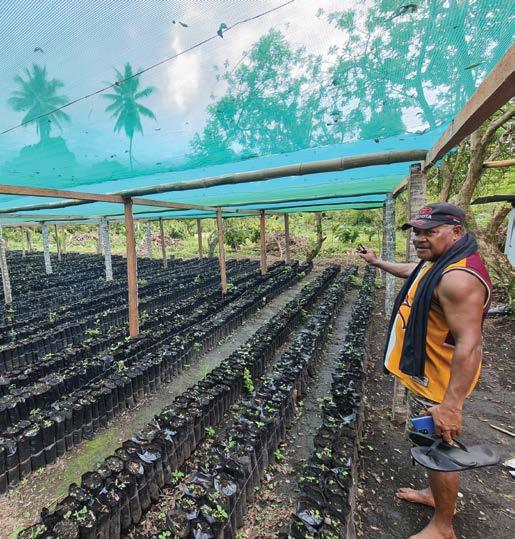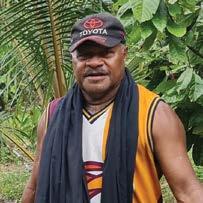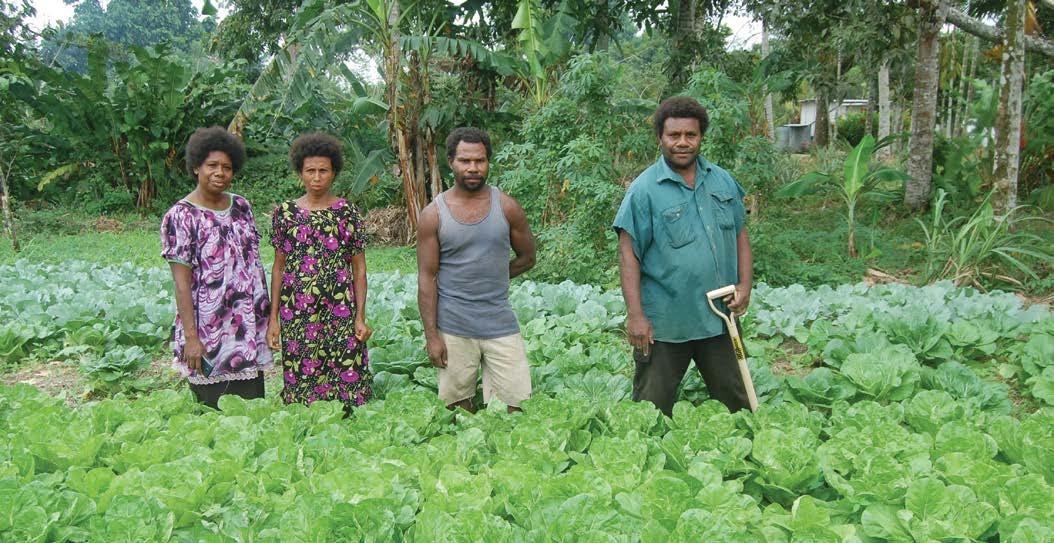
6 minute read
HELP IMPROVE CROPPING IN PAPUA NEW GUINEA
Cocoa production flourishes as a cash crop for Papua New Guinea’s smallholder growers, however vegetable farming has never been easy in the tropical climate –with implications for poverty and food security.
By John Gauldie
To address these challenges, the locals are working with the Papua New Guinea government and Volunteer Service Abroad (VSA) to draw on New Zealand’s horticulture expertise.
Mr Herman Valvalu (pictured below), a grower in Papau New Guinea’s island province of East New Britain, has been collaborating with the Department of Agriculture and Livestock (DAL) and New Zealand’s Volunteer Service Abroad (VSA) to improve agricultural practices among the nation’s majority smallholder farmers. He offers valuable insights into the region’s challenges and potential solutions.

While cocoa remains a significant export crop that brings money into the country, Herman highlights that “there is a problem with vegetable production and food security.”
The heat and humidity make traditional outdoor growing particularly challenging for delicate vegetable crops. Heavy rainfall can cause substantial crop damage. Disease pressure is high, and yield losses are significant without appropriate management techniques.
“Tomatoes grown here are very weak from humidity and stress,” Herman explains. The region experiences two seasons, wet and dry, with extreme conditions in both: “It can get very wet, the soil is very damp, or very dry, the sun is so hot, its stresses the plants.”
The consequences of these challenges are significant. In 2022, PNG imported US$37.6 million worth of fresh vegetables from Australia, many of which could have been grown locally. New Zealand also exports vegetables to PNG, including 2500 tonnes of onions, as well as frozen vegetables and potato products.
“Fresh fruit and vegetable production, capsicum and tomatoes are very, very expensive,” says VSA programme manager for Papua New Guinea Johannes Gambo. In many parts of Papua New Guinea, access to fresh vegetables like onions, tomatoes, and garlic – the backbone of everyday cooking – is a constant challenge.

“While the country’s Highlands are rich in agricultural potential, the journey from field to market is fraught with obstacles. Poor infrastructure, high fuel costs, and limited cold storage make it difficult to move fresh produce to coastal and urban areas affordably. Families often rely on alternatives like tinned fish, a shelf-stable protein that can be stretched with rice, noodles, or whatever greens are available.”
This price disparity makes nutritious fresh produce inaccessible to many, creating both a public health concern and a missed economic opportunity.
“There is a huge local market,” Johannes notes, with mining companies interested in purchasing fresh produce.
Herman emphasises the need to grow enough fresh produce for local demand instead of importing fresh vegetables, adding that “where there is a mouth, there is a market. There is a big local market, with demand for fresh quality, instead of frozen vegetables from Australia.”
Herman firmly believes that protected cropping systems offer the best solution to these challenges.
“We need greenhouse farms with a controlled, protected environment,” Herman states emphatically. “I think it’s the only way to increase production.” This approach could transform vegetable cultivation in the region by creating more stable growing conditions.

“Greenhouse production means better quality and uniformly grown produce”, he explains, as it allows growers to moderate crop damage by controlling humidity and providing better airflow.
Rather than envisioning large commercial operations, Herman sees an opportunity for smallholder farmers to adopt affordable protected cropping solutions. “We are thinking about small greenhouses, not mega structures.”
The tropical climate of East New Britain avoids one production input that New Zealand greenhouse growers wrestle with. “An advantage is that you don’t have to pay for heating the greenhouse,” Herman points out, which substantially reduces operational costs.
As a big advocator for fresh, quality produce, Herman believes in ensuring food security and lifting people out of poverty in the province by working in collaboration to train smallholder growers. He says the current situation “is not moving due to lack of knowledge. So we need to train them how to produce the best, how to take more farms to the next level, and build up the capacity of farmers.”
Herman envisions a practical approach to implementing protected cropping systems. “Most growers need a simple training module.” He suggests mobilising communitybased and cultural university resources, using organisations like VSA as a player in training. Crucially, the module needs to be developed locally to be compatible with the environment, the tropical climate and the social aspects.
Beyond infrastructure and technical know-how, access to quality inputs presents another significant barrier, particularly for seed, Herman explains. “We don’t have a breeding centre for vegetables. So there is a big demand for imported certified seed.”
He emphasises the need to “create a controlled environment so that we grow with the optimum use of the seed we have.”
A critical component of implementing protected cropping systems is knowledge transfer. “New Zealand is known as a leading horticulture specialist, known for high productivity,” Herman acknowledges. “Even though there is a big difference in climate, we can use New Zealand’s horticulture knowledge to improve our quality and yields.”

To demonstrate the potential of protected cropping, Herman proposes a pilot approach. “We are looking for a greenhouse grower to train the trainer. We want to learn from New Zealand to improve practices.” He suggests starting with a pilot greenhouse to demonstrate to local authorities the potential of investment.
“We need advice on that, I think it’s the only way to improve production,” Herman states. “The rest will come, but if we don’t try this, well, we don’t know what we don’t know. Let’s develop know-how and structures and see how it will deliver improvements. Nobody has done this, let’s break barriers.”
Johannes agrees that with improved access to quality seeds, knowledge, tools, and mentorship, small-scale growers have the potential to significantly enhance local supply chains and boost food security. “That’s where experienced farmers and horticulturists from New Zealand can make a real difference.”
ARE YOU THE NEXT VOLUNTEER IN PAPUA NEW GUINEA?
Volunteering offers New Zealand growers a unique opportunity to share their expertise in areas such as sustainable vegetable production, soil health, and post-harvest techniques. If you would like to join a growing network of Kiwi volunteers making a real impact in Papua New Guinea’s agricultural sector, and use your knowledge to help local farmers increase their yields, reduce waste, and feed their families with dignity, please contact VSA.
VSA covers accommodation, living allowances, airfares, and insurance, and provides in-country staff to ensure volunteers’ wellbeing throughout their stay. If you are interested, visit www.vsa.org.nz or email volunteer@vsa.org.nz










